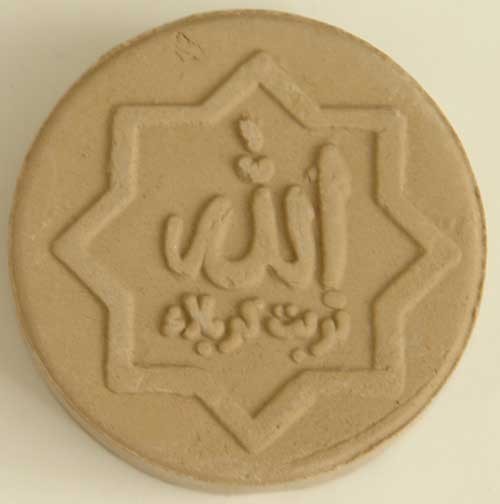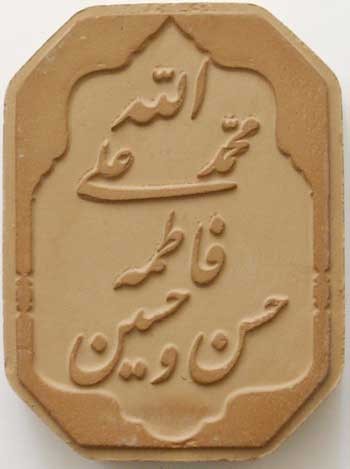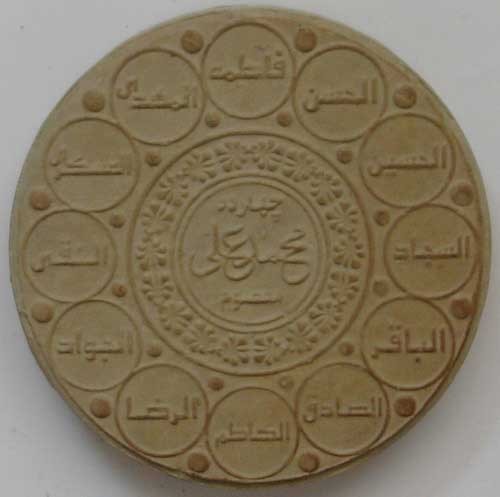Description
The Design has the Kaaba Building writing above it LA ILAHA ILLA ALLAH that means there is no god but Allah & the Dua used for GHOFEILEH Namaz Shia muslims practise between their Maghrib & Isha Salat or Namaz.
Shia Muslims have to use MOHR or Turbah in their Prayers called SALAT or NAMAZ. They place their Turbah inside such Clothes to protect being damaged. They also place the Turbah on these clothes to keep it clean & also as they pray & say words when their headfront on the Turbah no dust enter their mouth & get ill.
Many collectors worldwide collect them, due to the designs & artwork.
Ghufayla Prayer:
Ghufayla Prayer (Arabic: صلاة الغُفَیلة) is a well-known supererogatory prayer consisting of two rak’as (units) which is performed between the maghrib prayer and the ‘isha prayer. According to hadiths, this prayer is effective in one’s requests from God being responded to and one’s sins being forgiven by God.
In many mosques in Iran, Ghufayla prayer is performed between the congregational prayers of maghrib and ‘isha.
The Meaning of Ghufayla
The word, “ghufayla” (غُفَیلَة), is the diminutive (musaghghar) noun form derived from “ghafla” (غَفلَة) meaning a small neglect. According to a hadith from the Prophet Muhammad (s), the time between maghrib and isha’ prayers is the time of neglecting God, and this is why the Ghufayla prayer, which is said in this time, is called “ghufayla”. Imam al-Sadiq (a) taught the best manner of saying this recommended prayer to Hisham b. Salim, which is cited in Mafatih al-jinan.
In many mosques in Iran, Ghufayla prayer is said between the congregational prayers of maghrib and isha’.
Some Shiite scholars of fiqh (jurisprudence) hold that the well-known Ghufayla prayer is not independent from the nafila of the maghrib prayer, and so it can be intended as the two rak’as of its nafila.
Reward and Effects
Imam al-Sadiq (a) cited a hadith from the Prophet Muhammad (s) according to which the two rak’as of the Ghufayla prayer between maghrib and isha’ prayers should not be quit.
In a hadith from Imam al-Sadiq (a) narrated by Hisham b. Salim regarding the way the Ghufayla prayer should be performed, it is said that if one performs these two rak’as between maghrib and isha’ prayers and recite this supplication and asks God to respond to his or her requests, then God will respond to their request and give them whatever they want. The chain of the narration of this hadith is said to be reliable.
How to Say the Prayer
This two-rak’a prayer should be said after the maghrib prayer before the redness of the sky on its eastern part is gone. Ghufayla prayer should be said as follows:
In the first rak’a after reciting Sura al-Hamd, the Quranic verse, Quran 21:87-88, should be recited:
وَ ذَا النُّونِ إِذْ ذَهَبَ مُغَاضِباً فَظَنَّ أَنْ لَنْ نَقْدِرَ عَلَیهِ فَنَادَی فِی الظُّلُمَاتِ أَنْ لاَ إِلَهَ إِلاَّ أَنْتَ سُبْحَانَک إِنِّی کُنْتُ مِنَ
الظَّالِمِینَ فَاسْتَجَبْنَا لَهُ وَ نَجَّینَاهُ مِنَ الْغَمِّ وَ کذَلِکَ نُنْجِی الْمُؤْمِنِینَ
Wadha annuni idh dhahaba mughaḍiban fazanna an lan naqdira ‘alayhi fanada fi zzulumati an la ilaha illa anta subhanaka inni kuntu mina zzalimin (21:87) Fastajabna lahu wanajjaynahu mina alghammi wa kadhalika nunji almu’minin (21:88).
And remember Dhu l-Nun, when he departed in wrath: He imagined that We had no power over him! But he cried through the depths of darkness, “There is no god but thou; glory to Thee; I was indeed wrong!” * So We listened to him, and delivered him from distress, and thus do We deliver those who have faith.
In the second rak’a, after reciting Sura al-Hamd, the Quranic verse, 6:59, should be recited:
وَ عِنْدَهُ مَفَاتِحُ الْغَیبِ لایعْلَمُهَا إِلاَّ هُوَ وَ یعْلَمُ مَا فِی الْبَرِّ وَ الْبَحْرِ وَ مَا تَسْقُطُ مِنْ وَرَقَةٍ إِلاَّ یعْلَمُهَا وَ لا حَبَّةٍ فِی ظُلُمَاتِ الْأَرْضِ وَ لا رَطْبٍ وَ لا یابِسٍ إِلاَّ فِی کتَابٍ مُبِینٍ
Wa ‘indahu mafatihu alghaybi laya’lamuha illa huwa wa ya’lamu ma fi albarri walbahri wa ma tasqutu min waraqatin illa ya’lamuha wa la habbatin fi zulumati al-arḍi wa la ratbin wa la yabisin illa fi kitabin mubin
With Him are the keys of the unseen, the treasures that none knows but He. He knows whatever there is on the earth and in the sea. Not a leaf does fall but with His knowledge: there is not a grain in the darkness (or depths) of the earth, nor anything fresh or dry (green or withered), but is (inscribed) in a record clear
And then in the qunut, the following supplication should be recited:
اَللَّهُمَّ إِنِّی أَسْأَلُکَ بِمَفَاتِحِ الْغَیبِ الَّتِی لایَعْلَمُهَا إِلاَّ أَنْتَ أَنْ تُصَلِّیَ عَلَی مُحَمَّدٍ وَ آلِهِ
Allahuma inni asaluka bimafatihi alghaybi allati laya’lamuha illa anta an tusallia ‘ala muhammadin wa ‘lihi
O’ God, I ask You by appealing to the keys of the unseen that no one knows but You to send Your regards to Muhammad and his household
And then one should mention his or her requests from God with whatever language they prefer, and then they continue the qunut by reciting the following:
اَللَّهُمَّ أَنْتَ وَلِیُّ نِعْمَتِی وَ الْقَادِرُ عَلَی طَلِبَتِی تَعْلَمُ حَاجَتِی فَأَسْأَلُکَ بِحَقِّ مُحَمَّدٍ وَ آلِهِ عَلَیهِ وَ عَلَیهِمُ السَّلاَمُ لَمَّا قَضَیتَهَا لِی
Allahuma anta waliyyu ni’mati wa alqadiru ‘la talibati ta’lamu hajati faasaluka bihaqqi muhammadin wa alihi lamma qadaytaha li
O’ God, You are my benefactor, You are able to meet my need; You know my need, so I ask you by appeal to Muhammad and his household, peace be upon him and upon them, to meet my needs
The verse recited after Sura al-Hamd in the first rak’a of this prayer is known as the Yunusiyya dhikr (recitation of Jonah), because this is the supplication recited by the prophet Yunus (a) (Jonah) when he was swallowed by a great fish and asked God to help him out. The verse recited in the second rak’a of the prayer is concerned with the secrets of the unseen and the divine omniscience and omnipotence and the scope of God’s power and rule.
Repentance of Yazid
Some people claim that when Yazid b. Mu’awiya murdered Imam Husayn (a) and witnessed people’s dissatisfaction about the event, he asked Imam al-Sajjad (a) if there was a way for him to be saved from this sin. The Imam (a) told him that he could perform the repentance by saying the Ghufayla prayer. Lady Zaynab (a) asked the Imam (a) why he taught the way of repentance to the murderer of his father. Imam Sajjad (a) replied that Yazid will not be able to say the Ghufayla prayer.
This hadith is not cited in reliable collections of hadiths, and its content has been subject to objections.




Reviews
There are no reviews yet.